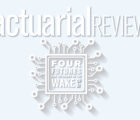
As the market demand for sophisticated analytical skills grows, many of our CAS members are looking at new career opportunities both inside and outside of the insurance industry. One of the newer frontiers that has already shown promise for actuaries in other countries is the banking sector. Now may be the right time to leverage this opportunity in the U.S. as well.
In mid-July we were excited to host Scott Hallworth, FCAS, the chief data officer and chief model risk officer at Capital One, as a presenter in our CAS Actuarial Innovator Profile webinar series, sponsored by the CAS Innovation Council. Hallworth is a pioneer in applying the actuarial skill set to banking at one of the nation’s largest banks. His presentation covered a number of important topics including the significance of data and advanced analytics in making decisions, Gartner’s 2017 “Hype Cycle of Emerging Technologies” and bank regulation. He also recommended articles for actuaries interested in banking careers and shared real-life examples of different analytical capabilities that Capital One uses to tackle mission-critical issues.
From leveraging analytical techniques like optical character recognition, neural networks and natural language processing, to using programming languages like R, SAS, Python and Spark, Hallworth made clear that not only are math skills portable, but that this is truly an ideal time to bring our actuarial skill set and modeling capabilities to bear in the banking arena. He also pointed out how features in the banking industry (bank deposits, loss forecasts) can be modeled using time-tested approaches that actuaries have developed in the insurance industry (claim reserves, economic modeling).
Features in the banking industry (bank deposits, loss forecasts) can be modeled using time-tested approaches that actuaries have developed in the insurance industry (claim reserves, economic modeling).
This article will leverage Hallworth’s presentation to highlight some key considerations for CAS members who want to learn more about opportunities to apply actuarial and analytical skills in banking.
People’s Analytical Skills: A Company’s Greatest Asset
For analytics to continue to evolve and advance in industries as fluid as banking and insurance, the skills and capabilities of people will form the backbone. Hallworth notes five areas that are critical for any organization to succeed when it comes to implementing models:
- Core and deep understanding of the math behind the analysis.
- Ability to work on a cross-functional and diverse team.
- Problem-solving abilities.
- Analytical abilities (statistical analysis, database programming).
- Keen business sense and perspective.
A quick visit to The CAS Institute and the pathway to the Certified Specialist in Predictive Analytics (CSPA) credential shows the CAS commitment to developing these five areas. Through online courses and five assessments, which address areas such as data concepts and visualization, predictive modeling methods and techniques, and a case study project, the CAS is helping actuaries and data scientists advance their analytic capabilities.
Data: An Opportunity for Math Experts
Every day we leave behind data about how we drive, what we buy, what we eat, what we read, where we travel, how we bank, how we surf the web and more.
As actuaries (i.e., “math gurus”), our careers are focused on analyzing a plethora of internal and external data sources and using advanced analytics to tease out themes and trends from the data. Hallworth points out that there is a high degree of context and understanding needed to create useful features from the mountain of unstructured (“raw” text, voice and image) and structured (utilization, claims and mortgage applications) data. At the same time, the complexity and depth of knowledge required to leverage unstructured data is much deeper than the respective levels necessary for managing structured data. Fortunately, we actuaries work daily with data, which exposes us to text mining and fuzzy matching. We also perform such tasks as handling protected health information, standardizing database elements, de-duping raw data, capping outlier values, addressing missing values and adjusting for changes in variable definitions over time. These types of skills are in great demand and are just as transferable to banking as our math skills.
Model Risk Management in Banking
For any actuary looking to learn more about models in banking regulation, Hallworth recommends reading two documents issued by the U.S. federal government:
- SR 11-7 – Guidance on Model Risk Management from the Board of Governors of the Federal Reserve System.1
- OCC Bulletin 2011-12 – Supervisory Guidance on Model Risk Management from the Office of the Comptroller of the Currency (OCC).2
At a high level, the documents define expectations for model management, covering topics such as risk, development, implementation, use and validation as well as ongoing monitoring and the resulting model risk. These expectations pertain to not just the modelers within a bank, but also the engagement throughout (e.g., escalation of issues to ensure that they are well managed). As noted in OCC Bulletin 2011-12, rigorous model validation plays a critical role in model risk management; however, sound development, implementation and model use are also vital elements. With models affecting areas such as product cross-selling, customer screening and retention, collections and fraud prevention, model management is more important than ever as the data available for analysis continues to grow exponentially.
There is a high degree of context and understanding needed to create useful features from the mountain of unstructured and structured data.
The March 2014 Claims Magazine cover story, “End-to-End Claims Analytics — An Equation for Financial Success,” tells stories from the field about the roles data science, implementation, communication and technology play in deploying models. The end-to-end analytic journey is a familiar one to actuaries and includes the following:
- Model deployment strategy.
- Predictive model development.
- Business and operational implementation.
- Organization change management.
- Performance management and loop-back improvement.
Our ability as actuaries to clearly articulate a model’s purpose, validate the segmentation power of the model, develop a well-defined implementation plan and foster a strong sense of ownership with the end users plainly aligns with SR-11-7 and OCC Bulletin 2011-12.
Closing
As Tony Robbins writes in his book Unlimited Power, “I believe it’s in your moments of decision that your destiny is shaped.” Let’s hope that the CAS decision to embrace creating opportunities in the banking industry will change the destiny of many future actuarial graduates who will one day call banking their home.
Kevin Bingham, ACAS, is managing director with Deloitte Consulting LLP in Hartford, Connecticut, and currently leads the company’s medical professional liability practice. He has over 25 years’ industry experience, including 20 in consulting, and has frequently written and presented on P&C industry trends. Aaron Halpert, ACAS, recently retired from KPMG’s Actuarial Practice and is an active CAS volunteer, having served as chair for Long Range Planning, Risk Management and Leadership Development Committees.
1 https://www.federalreserve.gov/supervisionreg/srletters/sr1107.htm
2 https://www.occ.treas.gov/news-issuances/bulletins/2011/bulletin-2011-12a.pdf
Actuarial Science Moves into Banking
In November 2016, South African actuaries published the article “SA Formalise the Role of Actuaries in Banking.” In it, the author shared that South Africa’s banking industry employs more than 300 actuaries. Michael
Tichareva, chair of the Actuarial Society of South Africa’s (ASSA) Banking Committee, notes that employing actuaries in banking is a relatively new trend, sparked mainly by global regulatory reforms, such as Basel II and III, and changes in international accounting rules.
In November 2017, the International Actuarial Association Banking Working Group and ASSA held a seminar in Chicago called “The Actuary in Banking.” The seminar included presentations by actuarial practitioners from South Africa, Canada and the United States, who covered topics such as the wide application of the actuarial toolbox to banking. These tools included modeling, setting assumptions, developing product cost and price, provisioning, and discerning relationships between assets and liabilities. The U.S. section focused on the opportunity facing CAS members arising from a new FASB accounting framework proposal for loan loss reserves and how our skill sets are well positioned to address the need. As current CAS President Brian Brown noted, the econometric variables underlying prepayment and foreclosure models (e.g., credit score, loan-to-value ratio, occupancy type, property type, loan term, etc.) and our actuarial skill sets are a perfect match.











